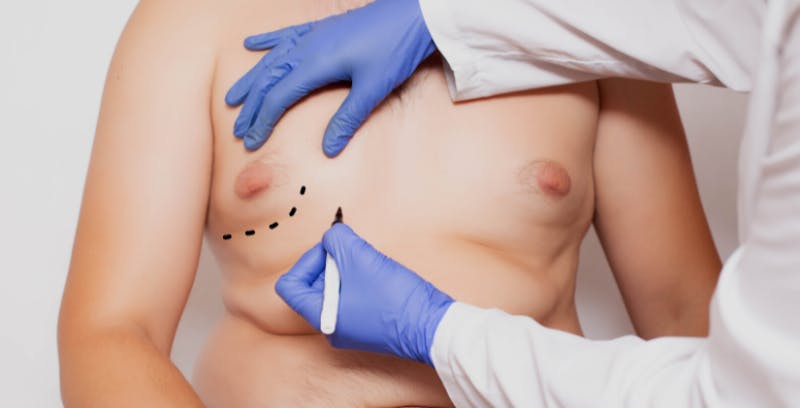
Nipples come in all shapes and sizes, and while this can be something to celebrate, it can also cause some people to feel self-conscious. Not all nipples look like what we expect. Puffy nipple, especially on men, may make some less confident about their bodies. However, it is not a serious medical issue and there are ways to combat puffy nipples, if you see it as something to change.
Achieving a specific appearance can make a big difference in self-esteem and confidence, and it should not be taken for granted. If you think you may have puffy nipples and feel self-conscious about them, you may be able to change their look. Keep reading to learn more about what they look like, what causes them, and several solutions to puffy nipples.
What Are Puffy Nipples
Puffy nipples are when the nipples or areolas form a mound shape and are more raised than the rest of the chest. They can develop on any body and often occur around puberty when hormones are changing.
While they are not dangerous, they result from an enlarged breast gland and can fall into the category of gynecomastia, increased breast tissue, specifically in boys and men. This can be a less desirable look for someone wanting a flatter, more masculine chest. Sometimes they develop during puberty and go away, but some people deal with them for longer.
It is common in young adults and is not always indicative of a long-term increase in breast tissue. Some boys and men who want to cover it up will try different strategies like tape, wearing multiple shirts, or other solutions. However, those are temporary options. And if puffy nipples stay past puberty, a more permanent solution might be best.
What Causes Puffy Nipples
Puffy nipples can develop for a variety of reasons. One of the most common is the bodily changes initiated by puberty. But an increase in breast tissue resulting in puffy nipples could be caused by several things, including:
- Excess fat
- Gynecomastia or enlarged breast glands
- Low testosterone
- Anabolic Steroids
Not all of these are permanent problems, meaning there are possible solutions outside of surgery. If you are dealing with puffy nipples or feel like you have enlarged breast glands, there are things you can try.
It’s important to remember that puffy nipples can develop at a certain point and then go away. If they start showing up around puberty, give it some time. Bodies change a lot while they grow, and often people’s bodies will change in certain areas over time. You don’t want to rush into any more invasive solutions like surgery before trying simpler options.
How to Treat Puffy Nipples
You will want to weigh your options for treating puffy nipples with when they developed and how long you’ve had them. If you have only had them for a little while and are still growing (around 20 years old or younger), you may just have to wait it out. Taking extreme actions when your body is still developing can have negative consequences, and most surgeons will not recommend working on younger individuals for that reason.
Take your time and try out a few of these options before considering more permanent and impactful options. There may be a combination of options that will help you handle puffy nipples at your own pace. And also, remember to give these solutions time to work. Most options are not overnight cures, so you must give your body time to change.
While it is important to remember you can change the look of puffy nipples, it’s important to remember they aren’t dangerous. Puffy nipples, especially on men, are not typically a sign of a more serious medical condition. Try not to stress too much over how to handle them and trust that one of these options will work for you.
Diet
If you have developed a puffy nipple due to lower testosterone or excess weight, your diet could be to blame. Puffy nipples can develop from too much fat and estrogen in the foods you eat. Try aiming for a more low-fat diet. Eat more fruits and veggies and avoid processed foods whenever you can.
Too much estrogen in the body isn’t good for men or women. If you’re worried that it could cause puffy nipples, try being more conscious of your diet. Eat foods like cauliflower, brussels sprouts, mushrooms, and broccoli. Add more turmeric to your diet, along with pomegranates and fatty fish. All these can help your body cut down on estrogen production and help balance your hormones. Other testosterone-filled foods that might help include garlic, blueberries, oysters, ginger, tuna, and egg yolks.
You should also avoid certain foods that could increase your levels. Overeating soy, meat and dairy, especially processed meat that might be treated with hormones, could cause higher estrogen levels. Cutting back on alcohol and certain nuts and seeds could also help.
It’s important to note that you shouldn’t cut out food groups entirely while dieting or trying to adjust your meals. You also shouldn’t dive into a diet that tries to cut out all estrogen, especially if you aren’t sure that that’s the cause of your puffy nipples. Start slowly by adjusting your diet to be healthier, and then work on adding and cutting out certain foods to see how you feel.
If puffy nipples result from excess weight, targeting them with a healthier diet could be the perfect solution. Eating less sugar, processed carbs, and dairy could help you reduce fat and get back in shape. Pairing a healthy diet with exercise is a great way to help your body return to a more comfortable shape and support your health along the way.
Supplements
Supplements are not a 100% guarantee for treating puffy nipples. If a lack of testosterone causes them, some supplements may help, but the evidence is mainly anecdotal, so it’s still important to maintain a healthy diet simultaneously.
If you want to try supplements as an additional solution, you can try certain herbs, including turmeric, ginger, dandelion, fenugreek, and Tribulus Terrestris. While they may help boost testosterone in some, you shouldn’t overdo it. You shouldn’t try taking supplements unless you are confident the issue is with your testosterone levels. If you are unsure whether to take them, speak with your doctor about what might be right for you.
In contrast, too much testosterone can also cause puffy nipples. Taking anabolic steroids to build muscle can cause an overabundance of testosterone which can be converted to estrogen by fat cells. This in turn, can cause breast tissue to form and puffy nipples.
Maintaining a healthy hormone balance can be tricky, and hormones can be easily thrown out of wack. You could be doing your body more harm than good if you don’t know whether or not you have a hormone imbalance. Working with a medical professional and nutritionist can give you a better chance of understanding where your body is in terms of hormones and how you can help it improve.
Exercise
If puffy nipples are due to excess fat, exercise is a great way to get a flatter, less pronounced chest. Specific chest exercises can help strengthen muscles and lower fat in that area. It is also a good idea to pair exercise with a healthy diet, so you have a better chance of seeing improvements and helping your health.
If you noticed puffy nipples when you gained weight, working out regularly should help them go down as you work off the extra weight. And working out your full body is the best way to get fit and ensure you don’t injure yourself by overworking one area.
There are specific exercises you can do to target puffy nipples, but you don’t want to push yourself too hard when you are first starting. If you do not exercise regularly, ease yourself into a routine. Start by working out 2-3 days a week. And then slowly increase that number. You want to keep a rest day in your exercise schedule each week, and if you are targeting certain areas, don’t work them out back to back. If you do chest and arms on Monday, do something else on Tuesday to help that area rest and grow more muscle.
Some exercises you can add to your routine to target the chest area include push-ups, bench presses, overhead presses, dips, and cable flies (low and incline). Start with lower weight and reps, working your way up as your body grows muscle and adjusts to a more regular workout.
You won’t be able to improve and shed any weight if you get hurt while exercising. Find a schedule that works for you and is easy to maintain. The surest way to lose progress is to give up on the process. Losing weight takes time, so allow your body the time to do the work and move at a pace that is safe and comfortable.
Puffy Nipple: Surgery
If diet and exercise cannot help with puffy nipples, and they aren’t due to puberty, surgery is an option. This is the most invasive and should not be taken lightly. Any surgery poses risks, so be sure to speak with a medical professional about what other steps might work for your body first.
There are a few surgical options used to treat issues related to puffy nipples. Liposuction, where chest fat is removed, is a fairly common procedure. It requires several weeks of recovery, which is expected with almost any surgical procedure.
There is a puffy nipple gynecomastia procedure, which specifically removes glandular tissue in the area. This is a relatively safe and simple procedure that does not take long. This procedure may be a good choice if you have tried other routes and nothing has worked well.
Chin Up, Chest Out
While puffy nipples are not typically a sign of medical concerns, they can cause someone to feel self-conscious and wish to hide their body. Some people may go to great lengths to ensure puffy nipples go unnoticed. Feeling confident and comfortable in your body can be good physically and mentally.
If puffy nipples are a problem for you, try some of the above suggestions. And if you feel like surgery would be a good choice, speak with a well-trained and licensed plastic surgeon, like Dr. Rogers and his team, to learn about your options. Schedule your consultation today and start feeling confident sooner.

